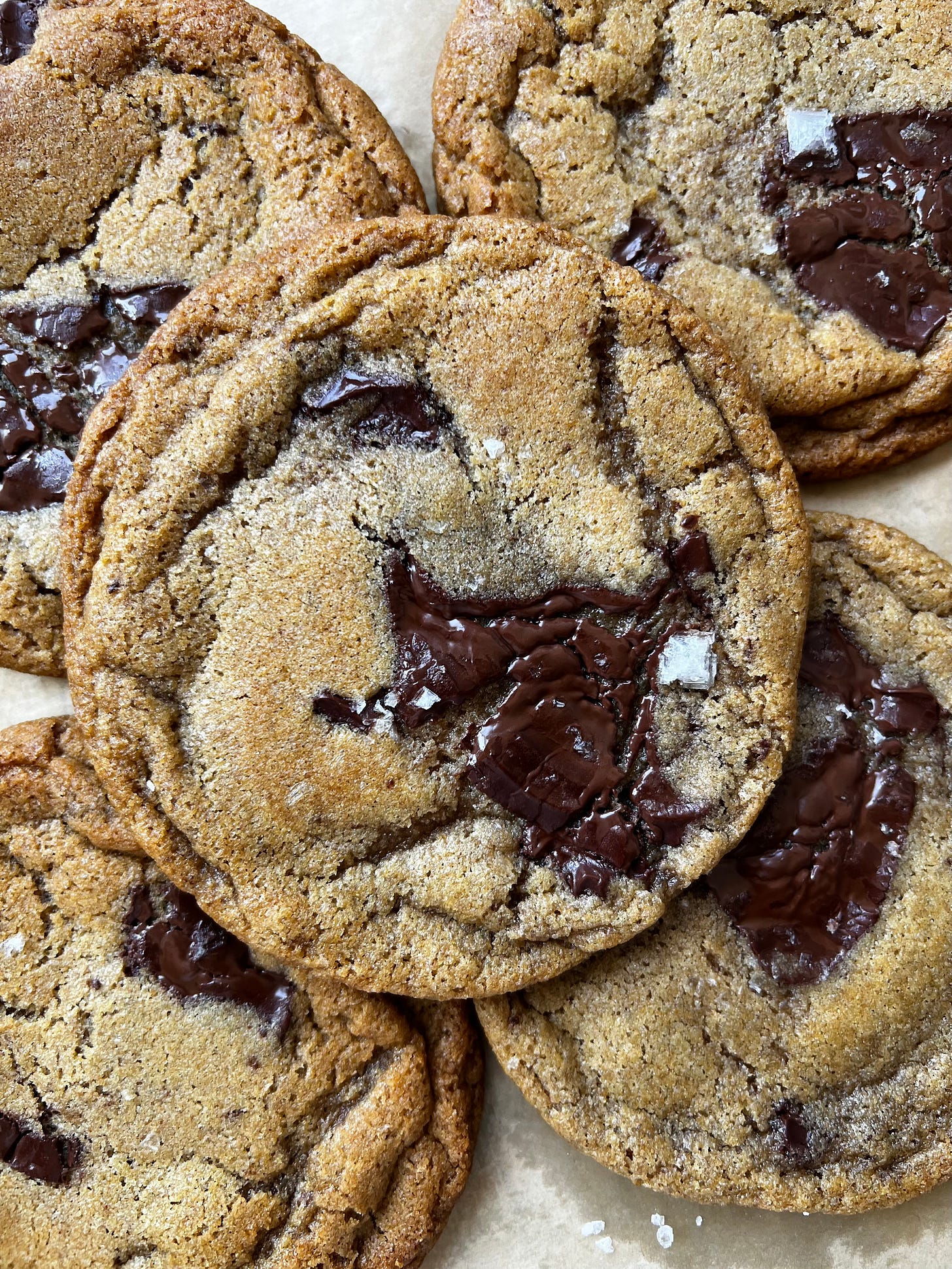dive into recipe riffin': a tale of two chocolate chip cookies
that started out as a different chocolate chip cookie <3333
hey hi hello,
Good to have ya back. But, if you’re new here, hello and welcome to bake chats :) Today we’re taking a look at a few of my favorite things in the world: baker’s ratios, chocolate chip cookies, and of course a little bit of recipe riffin’
For a long time we’ve all been told that, baking is a science and you cannot deviate from a recipe without it imploding. Which is only a half truth. Yes, baking is a science— ingredients need to fall with in certain percentage ranges + ratios for them to work. But, you can really push the bounds of those percentages and ratios before things break. I’m very preachy about needing a solid base recipe + a basic understanding of your ingredients to be able to riff and move through the kitchen with more creative ease. So, consider this a quick lesson in that <333
Let’s get to it, shall we?
*This post has a few affiliate links, which if you click and purchase from I receive compensation at no additional cost to you*
WHAT IS A RATIO?
It’s a fixed proportion of one ingredient in relation to other ingredients. Following a ratio will get you a a cake, a cookie, a loaf of bread etc. If you follow it in a very straight forward way- it’ll be good but, it won’t necessarily knock your socks off. Because ratios, very simply put look something like this “2 parts flour: 2 parts liquid: 1 part egg: 1 part butter” add a chemical leavening agent to the mix and you’ve got yourself a quick bread. Follow “3 parts flour: 2 parts fat: 1 part water” and you’ve got yourself a simple pie dough. “3 parts flour: 1 part fat: 2 parts liquid” + chemical leavening agent and now, were talking biscuits. They take a little time and care to make them into something special. Ratio vs Recipe.
You’ll notice- it’s not specific when it comes to the ingredients within the ratio. Right? It’s “just” flour, “just” liquid, “just” fat. Meaning, that when you’re developing based of these ratios, you can plug and play with *almost* any form of that ingredient based on what you’re going for. This is where that ingredient knowledge will really come into play. Theoretically though, you can plug and play with virtually anything here. Flour- you’re not bound to just All-purpose (though, a lot of the time that’s the best place to start) we’ve got: cake flour, bread flour, whole wheat flours— I’m talking spelt, sonora, rouge de bordeaux, rye, red fife, oh my god I could go on forever here but, you get the mf vibe. Liquids? That’s not just milk, you could go water, coffee (that’s just infused water), tea (more flavorful water!!), fruit juices, buttermilk, nut milks, in some cases sour cream/creme fraiche or even ricotta can plug into the liquid slot (but, they also have fat and acid so you gotta think about that when playing with ratios and other ingredients). Fats! Butter, canola oil, olive oil, coconut oil, lard, shortening, margarine— the list goes on!
So, developing a recipe from a ratio, is playing around with these ingredients and ratios until you have exactly what ya want. This is very much a tiny toe dip into ratios + developing, a primer if you will. If you want more on the subject, I highly, highly recommend checking out Ratio by Michael Ruhlman for more on that. I’ll also include links to other great resources at the bottom of this newsletter- with a full breakdown of my favorite books for developing & riffing to come at a later date!
The reason, I’m saying all this, is because down the line, when we have that finished recipe- you can still plug and play (once again, within reason) and push things pretty far before they break. Which, is why I put a lot of stock into developing solid base recipes that check all my boxes and you should too! Or, at the very least, find and use very solid base recipes as the jumping off points for your own creativity (with credit to the orig developer if thats the case!!). Having solid base recipes, puts you in this position where you can swap out a little bit of the AP flour out with a higher protein bread flour for a cookie with a little more chew to it. Take that a step further and instead of conventional bread flour- you can swap that for a high protein whole grain like rouge de bordeaux for a cookie that still has that chew but now has the warm flavor of the RdB!
THERE’S A LOT YOU CAN LEARN FROM A COOKIE




